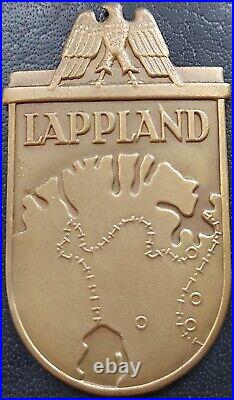
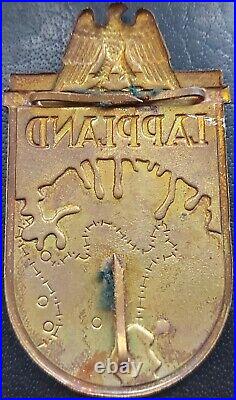
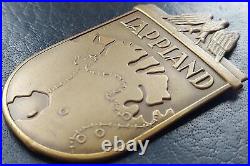
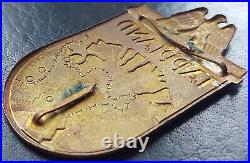
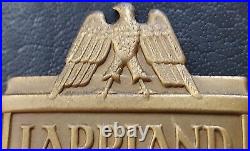
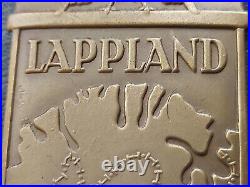
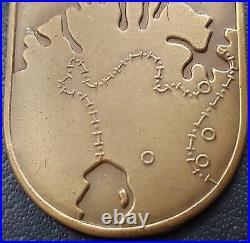
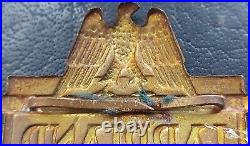
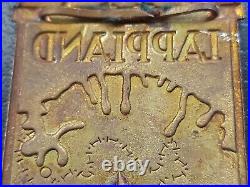
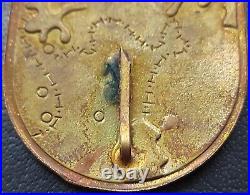
Genuine German post WW2 made / 1957 pattern Lappland Shield, IN VERY GOOD CONDITION, MAKER: ST&L (STEINHAUER UND LUECK), GOOD DETAILED EARLY EXAMPLE WITH THREE INTACT PRONGS – NOT EASY TO FIND. FEW FACTS ABOUT THE 1957 PATTERN AWARDS. In 1957 the West German government authorised replacement Iron Crosses with an Oak Leaf Cluster in place of the swastika, similar to the Iron Crosses of 1813, 1870, and 1914, which could be worn by World War II Iron Cross recipients. The 1957 law also authorised de-Nazified versions of most other World War II-era decorations (except those specifically associated with Nazi Party organizations, such as SS Long Service medals, or with the expansion of the German Reich, such as the medals for the annexation of Austria, the Sudetenland, and the Memel region). The main government contract to manufacture and supply these new de-nazified WW2 1957 official decorations went to the world famous German firm Steinhauer & Lueck, Luedenscheid Germany. Knights Crosses, Iron Crosses, Wound Badges, Tank Assault Badges etc were re-designed by Steinhauer & Lück – often with the oak-leaf spray replacing the swastika, with S&L having the sole patent rights to all WW2 1957 German decorations. S&L did not have the whole monopoly on medal making, other famous firms such as Deschler & Sohn, BH Maher and Juncker also manufactured these new German decorations. Lüdenscheid is situated between the cities Dortmund and Bonn. It was here that one of the youngest medal firms was founded in 1889 by August Steinhauer and Gustav Adolf Lück. The first production began in a cellar, the customer base continued to increase. A property was bought at 51 Hochstrasse which is still home for this famous company today. During WW2 Steinhauer & Lück produced medals and badges, like the famous Knights Cross and many other types of medals and badges. In 1957 this company was awarded the contract to produce all the newly re-designed legal WW2 1957 de-nazified decorations, plus the contract to manufacture all of Germany’s official decorations including Germany’s highest order the Bundesverdienstkreuz. Only a very limited number of original WW2 1957 medals are still produced, mainly Iron Crosses, German Cross Gold & Silver & Wound Badges and are considered 100% genuine by the German Government. HISTORY OF THE AWARD. Lappland Shield – this was the last officially instituted German battle shield of the war. This award, created in February of 1945, was to recognize the efforts of the 20th Mountain Army group commanded by General Boehme, who had been fighting a two front war against the English and the Russians since November 1944. The shield was officially approved on May 1st, 1945, a day after Hitler’s death. The Army surrendered to the British on May 8th, 1945. Thought the shield was recorded into Soldbuchs as early as April, it is believed that no awards were actually presented at this time. However, after the cessation of hostilities the German forces in the area found that their captor, General Thorne, went against common practice and allowed his prisoners to wear their decorations (it is of interest to note that the reason for the liberal attitude of the British forces was that at that time the possibility of using German troops to stem the Soviet advance had not been discarded). In light of this circumstance, the men of 20th Army began to produce the shield from whatever industry was available in the area (it was constructed from a variety of medals including zinc, aluminum and tin). Presentation of the award then took place, with the commanding German officer, General Boehme, in charge of this task. It has been stated that the criteria for the shield included 6 months service in the area, to have been wounded in an engagement in the area or to have attained a bravery award in the area. Even though the award was presented after the end of the war, it should be considered an official award as it was authorized prior to the capitulation of the Wehrmacht. The award itself consisted of a crudely constructed shield which had a rounded bottom and a flat top, with a rim running along the edge of it. Immediately below the top there was a horizontal bar with an eagle perched on it. The eagle in the shield does not include a swastika, as this of course would have been unacceptable to the Allied forces. Immediately beneath this is the word “LAPPLAND” and under it there was a map of the area. On the edges of it four small holes were perforated from which the shield was sown to the uniform. Needless to say, this award has countless variants and, being field produced, was of a very low quality.